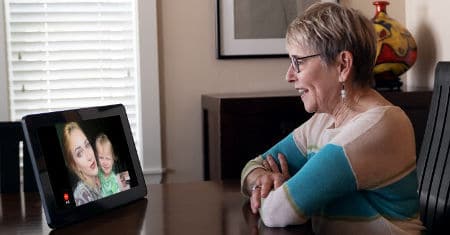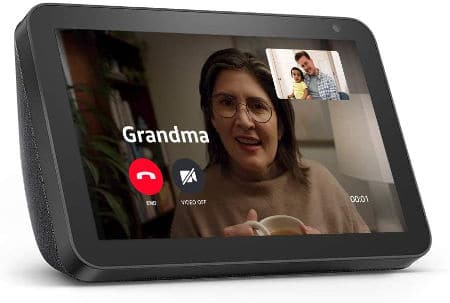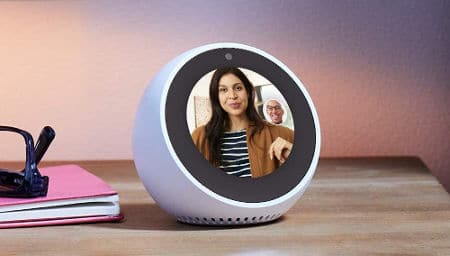How to Video Chat for Old People Easy to Use
Due to Covid-19, families may have a tough time keeping in touch and seniors may feel isolated or abandoned. This can be devastating for people with Alzheimer's or dementia who aren't able to use popular video calling apps and may not understand the situation.
Michael Cottam , who cares for his father-in-law with dementia who lives in a nursing home, was struggling with this too. Then, he figured out how to make video calls without needing his father-in-law to press buttons and without needing help from staff each time. Here, he shares a solution everyone can use and setup mistakes to avoid.
Coronavirus lockdown has been devastating for people with Alzheimer's or dementia
The coronavirus pandemic has made it very difficult to keep in touch with someone who lives in a nursing home or assisted living community.
To reduce exposure to Covid-19 , most of these places are in lockdown, which means that family and friends aren't allowed to visit in person – only staff can enter the building.
To make matters worse, group activities and dining room meals inside many care communities have been suspended to keep residents physically distanced to help reduce the spread of the virus.
This level of isolation and the major changes in daily routine has been especially devastating for people with Alzheimer's , dementia , and other cognitive impairments.
Accustomed to regular family visits and not being able to comprehend what a global pandemic is, someone with dementia doesn't understand why they're suddenly alone and often feels abandoned.
Sure, there are plenty of video calling apps and devices out there, but for many older people, using these modern apps is confusing and overwhelming.
And if they have memory issues, it's even harder – you can teach them how to use the device on Tuesday, and by Thursday they've forgotten everything you taught them.
How we lost and then regained our connection with my father-in-law
When the pandemic started, my family was cut off from my father-in-law who has dementia and lives in a memory care community .
The care community staff was busy with added tasks due to Covid-19 and couldn't spend much time helping residents connect with their families.
Without their help, it's nearly impossible for families to stay connected because someone with more advanced dementia isn't able to initiate or accept video calls, no matter how simple the technology.
And even without memory issues, most people in nursing homes aren't terribly comfortable with new technologies like smartphones, touch screens, and voice recognition devices.
When we were able to get in touch with my father-in-law, we were shocked and saddened to see how quickly he had declined in such a short time.
He got to the point where he couldn't figure out how to answer his Android phone when it rang – let alone make a call himself. And then he'd forget to plug it in to recharge it, so when we'd call, we'd always get his voicemail.
So, I figured out how to put a video calling system in place that would let us see and talk with him – without any action needed on his part.
We'd call, he'd hear our voices, turn towards the sound (he'd forget he had the device in the room until then), see our faces, and all he had to do was smile and say hello.
After we were able to regularly video chat with him, my father-in-law improved significantly.
Interestingly, we found conversations with him went much better when we could see each others' faces – often, plain old phone calls would for some reason turn adversarial.
To help others in similar situations, I found 3 devices that make it possible to video chat with someone who can't answer a call. They use a feature called "drop in" calling.
Another plus to using these types of devices is that they're plugged in all the time – the person doesn't have to remember to recharge them.
My father-in-law would sometimes realize that his smartphone needed to be plugged in and we found that he'd tried things like his electric razor cord or had plugged in one end of a USB cable, but pulled the other end out of the USB charging brick.
All those problems go away with a permanently-plugged-in device that sits next to his TV.
I also share the tips that helped me get our Echo device and "drop in" calling feature set up ahead of time (so I needed minimal help from the nursing home staff), what to do if their WiFi connection is too weak, and a resource for financial assistance.
"Drop in" calling lets you make video calls to someone who can't answer
"Drop in" calling means that the device answers your call with no action needed on the part of the person receiving the call.
It can be a really important feature if the person in the nursing home has forgotten how to answer the phone.
With a device that has "drop in" calling, you just place it in the room where they usually read or watch TV. Then when you call, you just appear on the screen, they hear your voice, turn and see you, and off you go.
The other advantage of "drop in" calling is that it doesn't require a very old set of fingers to try and make a touch screen operate.
My father-in-law's hands are very dry and wrinkled. I've watched him try to swipe to answer his smartphone a half dozen times and the screen just didn't recognize the touch like it would for a younger pair of hands.
3 video call devices with "drop in" calling

1. ViewClix Smart Frame – 10-inch screen ($200) & 15-inch screen ($300)
This is a smart picture frame that displays digital photos and has video calling with an auto-answer mode.
When choosing a screen size, think about your family member's vision: is it poor, or starting to go? If so, go with a bigger screen.
When auto-answer is set up, the older adult doesn't need to do anything to receive a video call.
There's no power switch, so the device is always on. It displays photos and is always ready for video chatting or to show newly added photos.
You'll set up a secure Share List with the names and email addresses of people who will be authorized to share pictures and make video calls.
You sure don't want solicitors (or people they might have a rocky relationship with) to be able to just parachute into their room at any time of the day or night!
You can also remotely manage the device from any web browser and set features like: if you want the frame to auto-answer video calls, how long each Slideshow picture is displayed, and whether the ViewClix Smart Frame goes to "sleep" during late night hours.
Watch a 30 second video to see how the ViewClix Smart Frame works
See ViewClix Smart Frame customer reviews
Note: ViewClix Smart Frames are more expensive (Echo devices are often discounted from the list prices shown below), but as you'll see below, the Echo setup process is more complicated.

2. Amazon Echo Show
The Echo Show is an Alexa personal assistant (like an Echo or Echo Dot) with a video screen.
To make video calls without your older adult needing to accept the call, use the Echo Show's "drop in" feature.
This feature allows you (or other preselected relatives or friends) to start a video call and automatically appear on the Show's screen and be able to speak with and hear your older adult – they just need to be in earshot and don't need to do anything.
"Drop in" calls can be made between two Echo devices and you can also initiate a "drop in" call using the free Amazon Alexa app from your smartphone.
Currently, there are 3 of these types of devices available (prices frequently discounted):
- $90 Echo Show 5 – 5.5" screen
- $130 Echo Show 8 – 8″ HD screen and stereo sound, many customer reviews say this is the best of the three Show options

3. $130 Amazon Echo Spot (price frequently discounted)
The Echo Spot has a small screen, but has the same video calling and drop in features as the Echo Show.
This would have worked just as well for my father-in-law because he doesn't have any vision issues at this point, but screen size might make a difference for your family member.
How to set up the "drop in" feature on an Amazon Echo device
We decided to get my father-in-law an Echo Show and while it was a bit complicated to get it set up (learn from my mistakes below), once it was up and running, it's been smooth sailing.
This article from Digital Trends walks through how to set up the drop in feature for an Echo device.
This article from HelloTech also has instructions and screenshots for how to set up the Alexa app to make drop in calls.
And this article from AT3 Center includes a video demo of the drop in feature (scroll toward the middle of the page) so you can see how it works.
If you need help getting the Echo set up, chat online or speak with an Amazon representative over the phone.
To reach an Amazon representative on the phone, visit their Contact Us page and choose the smaller "We can call you" link underneath the big "Start chatting now" button and provide the necessary details to get connected to someone who can help.
How to prepare a device to connect to the internet at a nursing home
To make sure you can communicate with the device and minimize time and effort needed from care community staff, you should do as much set up as you can ahead of time.
That's why you'll need to have the device shipped to your own house first.
You can remove all the excess packaging, plug it in, and set it up to connect to your own home WiFi network.
Then, set up any apps or devices you'll need on your side.
Get familiar with the settings and maybe take some photos of the screens with your smartphone so if the person in the nursing home helping with the set up has any questions, you'll know what they're looking at and be able to answer.
Remember, when you deliver the device to the nursing home, they're going to take it inside (where you can't go), wipe it down, and then you're probably going to have to walk them through the setup from the other side of a door or on the phone.
You're NOT going to be able to stand next to them and do the setup yourself.
Most likely, the help you'll need from a care community staff member is for them to:
- Place the device in a good location in your older adult's room, preferably near where they usually like to spend their time (and where you can easily see each other) and plug the power cord into a wall outlet without creating a tripping hazard.
- Change the WiFi network name and password to the one the care community uses.
- Use your family member's mobile phone to get and enter the verification code.
To make things easier for a staff member, you could write down the necessary steps and include your phone number so they can call you if they need help and to let you know when it's all set up.
You might even want to tape your name and phone number to the back of the device so a staff member can easily contact you in the future if there's ever a problem.
VERY IMPORTANT: Never use your own phone number for their Echo device
DON'T set their Echo up initially with your own mobile phone number to test it out! Changing that over to your family member's mobile number is excruciatingly difficult (but necessary).
Because my father-in-law couldn't reliably answer his mobile phone (and never EVER managed to figure out how to read a text message), we had to ask a staff member at the care home to go to his room and work his phone for him during the setup process.
That included entering his mobile phone number into the Echo device, sending a verification code to their mobile phone, and entering that verification code back into the Echo device.
If they don't have a mobile phone or if you really want to set up and test the whole system ahead of time
Some seniors in nursing homes may not own a mobile phone. If that's the case, you don't necessarily need to buy them one in order for them to use the Echo device.
But you can't just use your own mobile phone number – that's where I got into trouble.
At first, I set up the Echo using my own mobile phone number, thinking that I could test it out and change it later.
Then, I installed the Amazon Alexa app on my mobile phone. When I tried to call the Echo device using the Alexa app, it seemed to get lost and not know which device to try to talk to. Maybe the Echo felt like it was calling itself and got confused.
I didn't try this option myself, but based on my experience, I think you can associate the Echo to any mobile phone (as long as it can receive text messages), you just cannot ever use that specific mobile phone to call the Echo device.
So if your older adult doesn't have a mobile phone or if you wanted to set everything up ahead of time, you could use someone else's mobile number for the set up process as long as that person will never video call your older adult's Echo using that mobile phone number.
In case you're interested, here's our family's current setup:
My Apple iPhone
- Mobile number 503-349-xxxx
- Alexa app installed from Apple App store
Father-in-law's Echo Show
- Mobile number 541-xxx-xxxx (his actual mobile phone number)
- Alexa is built-in
Father-in-law's Android mobile phone
- Mobile number 541-xxx-xxxx (same as used for the Echo Show)
- NO ALEXA APP INSTALLED HERE
My sister-in-law's Android phone
- Mobile number 360-xxx-xxx
- Alexa app installed from Google Play
What to do if the nursing home's WiFi connection is weak
If the internet connection is slow or too many people are using a care community's WiFi network, video chats can get choppy or get cut off completely.
If this is a frequent problem, but cellular signals are strong at their location, you might consider getting a WiFi hotspot to place in your older adult's room.
Major cell phone carriers like AT&T , Verizon , T-Mobile , Mint Mobile , and others sell mobile hotspot devices and service plans or allow you to use a smartphone as a hotspot.
AT3 Center shares tips on how to take an old smartphone and use it to create an internet hotspot. Be sure to check with your specific carrier to make sure this will work.
Generally, you'll need to:
- Add a line to your mobile phone plan and plug the smartphone in so it has continuous power.
- Check the smartphone's user guide to find out how to activate the "personal hotspot" option.
- Change the device's WiFi network name and password to the hotspot's.
Financial assistance for video calling devices
If paying for a device is a challenge, contact your State AT Program (from the National Assistive Technology Act Technical Assistance and Training (AT3) Center) to learn about funding options available in your state.
If you want to just try it out, ask if your State AT Program has an Echo Show to borrow from their short-term device loan program.
Equipment loans are a great way to see if the device can work for you and your older adult. Some programs may also offer virtual demonstrations.
Recommended for you:
- Amazon Echo Alexa for Seniors with Dementia
- Nursing Home Lockdown: 6 Ways to Stay Connected with Seniors During a Coronavirus Scare
- 8 Mental Health Tips for Caregivers During Coronavirus
- 8 Shelter-in-Place Coronavirus Tips for Senior Care in Your Home
Guest contributor: Michael Cottam is a business marketing consultant from Bend, Oregon. He's an avid traveler, a scuba diver, and a father. He has been caring for his father-in-law with dementia for several years.
This article wasn't sponsored, but does contain affiliate links. We never link to products or services for the sole purpose of making a commission. Recommendations are based on our honest opinions. For more information, see How We Make Money.
Source: https://dailycaring.com/best-way-to-make-video-calls-to-seniors-with-alzheimers-or-dementia-in-nursing-homes-during-coronavirus/